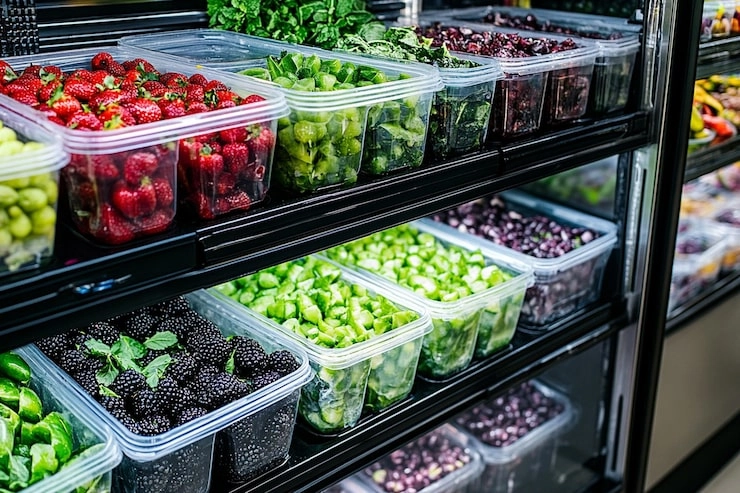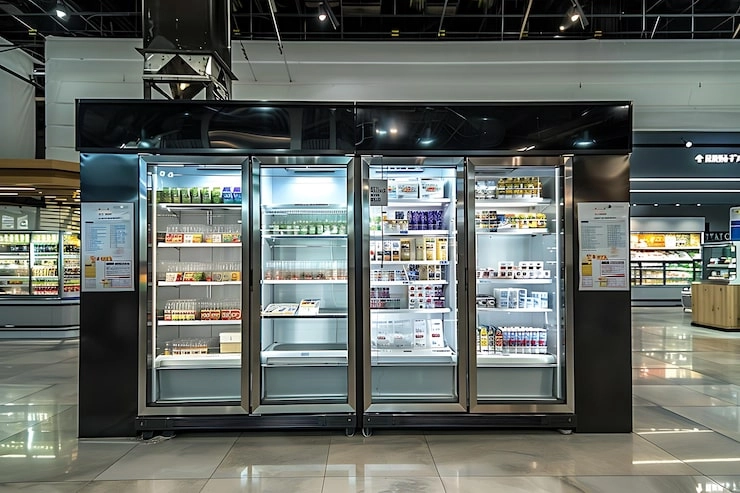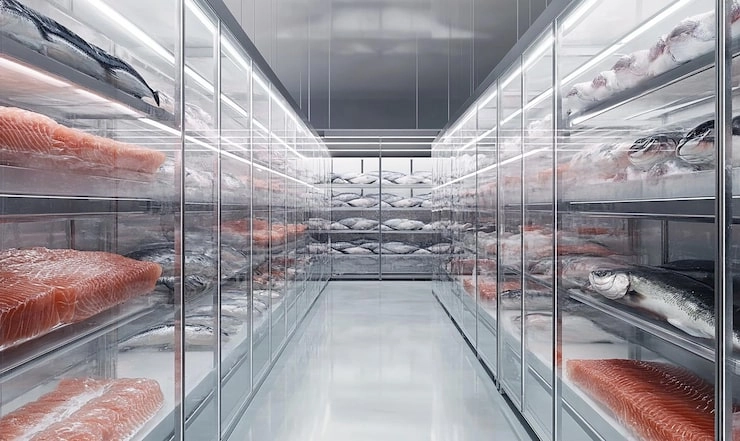
This is a key issue in the food service world. It calls for a thorough look at how we preserve food. We’ll uncover if frozen goods are as secure as folks think. To start, let’s check out the everyday view of the freezer. And the big questions that pop up from it.
The Common Belief: Freezers as a Fortress of Preservation
Most people see the freezer as a wonder box. Time freezes there. It’s a strong hold for keeping foods safe. Think summer berries or hearty dinners—they stay just right. Right in the middle of this cold realm sits a favorite gem: ice cream. We figure that once it’s rock-hard frozen, it’s protected from rot that hits fresh stuff. Especially from sneaky foes like mold.
Posing the Question: Is Our Ice Cream Truly Safe from Spoilage?
But hold on—is that idea spot on? Spotting mold on bread or apples is no shock. Yet seeing it on a dollop of frozen vanilla feels way off. This sparks a cool puzzle for a chilly snack. Can the tough, widespread power of mold beat the harsh chill of a freezer? And take over our ice cream?
What This Article Will Uncover
This piece will get into the icy truths. We’ll check the facts on mold. How cold temps slow its spread. And if your go-to frozen delight is really shielded. Besides, we’ll sort out mold from other usual ice cream woes. Like freezer burn. Plus, we’ll share top tips to keep your goodies fresh and fine.
With those points in mind, we dive into the main suspect first.
Understanding the Enemy: What Exactly is Mold?
Let’s unpack the core traits of this typical home bother. To grasp what drives it.
The Basics of Mold: A Fungus Among Us
Before figuring if mold can thrive in a freezer, we must know its makeup. Molds count as fungi. That’s a bunch of tiny critters found almost anywhere. Inside or out. Their seeds are light. They float on air currents. They stick to spots. And if the setup fits, they start to spread.
The Three Ingredients for Growth: Food, Water, and Temperature
Mold picks easy targets. Yet it needs a basic mix to boom: a meal source, some wetness, and the right heat level. Ice cream offers plenty to eat. Sugar and fats count. It holds water too. Locked as ice bits. The top roadblock? The chill. Most molds love warm, soggy spots. Not the polar setup of a freezer.
Can Mold Spores Survive in the Cold? The Resilient Nature of Microbes
Mold favors heat to expand. Still, its seeds are super tough. Cold snaps don’t wipe them out. They just go quiet. Dormant. Hanging tight. Set to wake up fast. And kick off growth when things warm up again.
Now we’ve got the scoop on mold. What it craves. We can probe how freezing fights back against its push.
The Science of Freezing vs. Fungal Growth
At the root of the freezer’s guard lies this: how low temps hit the must-haves for living things.
How Freezing Temperatures Inhibit Mold Growth
A regular freezer hits 0°F (-18°C) or less. There, the water in ice cream turns to solid ice. Mold needs free-flowing water. To grab food and build up. So the locked-up state in ice cream starves it out. The frost doesn’t end the seeds. But it slams the brakes. No multiplying allowed.
The “Danger Zone”: Why Thawing and Refreezing is a Problem
Trouble brews in the “danger zone.” That’s 40°F to 140°F (4°C to 60°C). Say you park a tub on the counter too long. It softens up. That hands liquid water to sleeping mold seeds. Then if you freeze it back. You might trap early mold starts from the melt time. Cycles of thaw and freeze? They build rough, frosty feel. And ramp up rot risks big time.
Freezer Burn vs. Mold: Learning to Spot the Difference
Folks often mix up freezer burn with mold. Freezer burn hits when dampness shifts. From solid to gas. Then back to big ice chunks on top. It shows as flat, faded spots. It wrecks chew and taste. But it’s safe. No harm. Mold? That’s fuzzy, off-color marks. Green, black, or white often. And it’s super rare on well-kept frozen ice cream.
With the facts clear now. We tackle the big query straight up.
The Verdict: Can Mold Grow on Frozen Ice Cream?
Time to hit the core point. Based on what we’ve laid out.
The Direct Answer: Why It’s Extremely Unlikely in a Stable Freezer
Can mold take hold on frozen ice cream? Flat out, no. In a steady freezer at 0°F (-18°C) or under. The setup just won’t let mold push ahead. No loose water means no chance. For the fungus to roll.
The Scenarios Where It Could Happen: Cross-Contamination and Temperature Abuse
Sure, it’s a long shot. But spots exist where mold might show on ice cream.
- Temperature Abuse. Freezer quits. Or the tub sits out ages. It thaws. Mold could kick off then.
- Cross-Contamination. A moldy bit—like stale bread—brushes soft ice cream. Seeds jump over. If it hangs in the danger zone next. That mold might sprout. Before the refreeze locks it.
The Real Culprits: What Spoils Ice Cream Besides Mold?
Mold’s not the top threat. Other stuff ruins ice cream more. Freezer burn leads. It crafts a nasty, frosty bite. Ice cream soaks up smells too. From nearby freezer foods. That brings weird tastes. Plus, fats turn sour over time. Even in cold. Leading to flat flavor.
Spotting the dangers helps. So let’s grab tips to dodge them. Through smart care and stash.
Best Practices for Keeping Your Ice Cream Pristine
A handful of easy rules shift everything. For tasty, secure ice cream.
Proper Storage Techniques for Maximum Freshness
Guard your ice cream this way. Tuck it at the freezer’s back. Temps stay even there. Seal the top firm. For bonus shield, lay plastic wrap right on the top. Before the lid goes back. That blocks ice bits from building.
Maintaining an Optimal Freezer Environment
Set your freezer to 0°F (-18°C) or cooler. Skip long door hangs. A packed freezer works better than bare. Stock it full. But leave room for air flow. What’s more, that keeps things humming smooth.

Signs It’s Time to Throw Your Ice Cream Out
Toss if mold shows clear. Ditch it for thick ice sheets too. Or if it shrinks up. Feels grainy or slick. Smells sour or wrong. Doubt hits? Better safe. Bin it.
Home care counts. Yet for big ops, pro gear sets the base. For frozen food guard on a work scale.
Partnering with Commercial Refrigeration Experts
In shops, the pressure’s on. Gear choice shapes the biz game.
The Importance of Reliable Freezing Technology
For spots like ice cream shops, diners, or stores. Stopping rot’s no joke. It’s safety. And cash flow. All hinging on top-notch cold tech. Pro freezers hold tight temps. Even with doors flipping often. To lock in goods’ prime state.
Solutions from Shandong Create Refrigeration Co., Ltd. for Commercial Needs
Here’s where gear pros step in. Firms like Shandong Create Refrigeration Co., Ltd. shine. They craft sturdy cold setups. From eye-catch ice cream show freezers. That draw folks in. While nailing store chills. To huge walk-in units. Key for stock rooms. Their push on strong build and fresh ideas. Aids shops in holding frozen stock true.
Ensuring Food Safety and Product Quality with Professional Equipment
Betting on pro tools? Smart move for any outfit. It seals food guard. And top-shelf goods for buyers. Solid freezers from pros like Create Refrigeration. Block temp swings. That spark freezer burn, feel loss. And worst, rot starts.
We’ve sifted the facts, threats, and pro fixes. Now wrap it up.
Conclusion: Sweet Dreams, Not Moldy Nightmares
Quick scan of our chill chase takeaways.
Recapping the Key Findings
Moldy ice cream thoughts unsettle. But science calms nerves. A good freezer’s bite shuts mold out. Near total block. True foes? Temp shifts and bad stows. They hit with freezer burn first. And quality dips. Long before mold stirs.
Final Thoughts on Food Safety in the Freezer
Your freezer rocks for hold-overs. Not a magic clock though. Stick to smart stows. Watch the chill close. Your ice cream stays yummy. No fungus fights. So chill out. Frozen sweets dodge the bad guys.
To cap our chat, quick hits on hot queries.




















